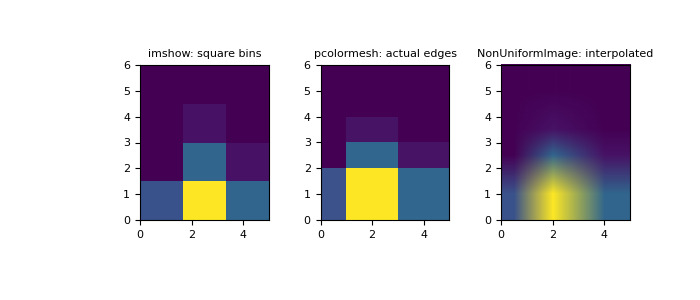本文简要介绍 python 语言中 numpy.histogram2d 的用法。
用法:
numpy.histogram2d(x, y, bins=10, range=None, normed=None, weights=None, density=None)计算两个数据样本的二维直方图。
- x: 数组, 形状 (N,)
包含要进行直方图分析的点的 x 坐标的数组。
- y: 数组, 形状 (N,)
包含要直方图的点的 y 坐标的数组。
- bins: int or 数组 or [int, int] or [array, array], 可选
箱规格:
如果是 int,则为二维的 bin 数量 (nx=ny=bins)。
如果 数组,则两个维度的 bin 边 (x_edges=y_edges=bins)。
如果 [int, int],每个维度的 bin 数(nx, ny = bins)。
如果 [array, array],则每个维度中的 bin 边 (x_edges, y_edges = bins)。
[int, array] 或 [array, int] 的组合,其中 int 是 bin 的数量,array 是 bin 的边。
- range: 数组,形状(2,2),可选
沿每个维度的 bin 的最左侧和最右侧边(如果未在箱子参数):
[[xmin, xmax], [ymin, ymax]].此范围之外的所有值都将被视为异常值,并且不计入直方图中。- density: 布尔型,可选
如果默认为 False,则返回每个 bin 中的样本数。如果为真,则返回概率密度函数在箱子,
bin_count / sample_count / bin_area.- normed: 布尔型,可选
行为相同的密度参数的别名。为了避免与破坏的规范论证混淆numpy.histogram,密度应该是首选。
- weights: 数组,形状(N,),可选
一组值
w_i称量每个样品(x_i, y_i).如果权重归一化为 1规范的是真的。如果规范的为 False,返回的直方图的值等于属于每个 bin 的样本的权重之和。
- H: ndarray,形状(nx,ny)
样本 x 和 y 的二维直方图。 x 中的值沿第一维进行直方图,y 中的值沿第二维进行直方图。
- xedges: ndarray,形状(nx+1,)
bin 沿第一个维度边。
- yedges: ndarray,形状(ny+1,)
箱沿第二个维度边。
参数:
返回:
注意:
什么时候规范的为 True,则返回的直方图是样本密度,定义为使得产品的 bin 上的总和
bin_value * bin_area是 1。请注意,直方图不遵循笛卡尔约定,其中x值在横坐标和y纵坐标轴上的值。相当,x沿数组的第一个维度(垂直)进行直方图,并且y沿数组的第二维(水平)。这确保了与numpy.histogramdd.
例子:
>>> from matplotlib.image import NonUniformImage >>> import matplotlib.pyplot as plt构建具有可变 bin 宽度的二维直方图。首先定义 bin 边:
>>> xedges = [0, 1, 3, 5] >>> yedges = [0, 2, 3, 4, 6]接下来我们创建一个带有随机 bin 内容的直方图 H:
>>> x = np.random.normal(2, 1, 100) >>> y = np.random.normal(1, 1, 100) >>> H, xedges, yedges = np.histogram2d(x, y, bins=(xedges, yedges)) >>> # Histogram does not follow Cartesian convention (see Notes), >>> # therefore transpose H for visualization purposes. >>> H = H.Timshow只能显示方形箱:>>> fig = plt.figure(figsize=(7, 3)) >>> ax = fig.add_subplot(131, title='imshow: square bins') >>> plt.imshow(H, interpolation='nearest', origin='lower', ... extent=[xedges[0], xedges[-1], yedges[0], yedges[-1]]) <matplotlib.image.AxesImage object at 0x...>pcolormesh可以显示实际边:>>> ax = fig.add_subplot(132, title='pcolormesh: actual edges', ... aspect='equal') >>> X, Y = np.meshgrid(xedges, yedges) >>> ax.pcolormesh(X, Y, H) <matplotlib.collections.QuadMesh object at 0x...>NonUniformImage可用于显示带有插值的实际 bin 边:>>> ax = fig.add_subplot(133, title='NonUniformImage: interpolated', ... aspect='equal', xlim=xedges[[0, -1]], ylim=yedges[[0, -1]]) >>> im = NonUniformImage(ax, interpolation='bilinear') >>> xcenters = (xedges[:-1] + xedges[1:]) / 2 >>> ycenters = (yedges[:-1] + yedges[1:]) / 2 >>> im.set_data(xcenters, ycenters, H) >>> ax.images.append(im) >>> plt.show()
也可以在不指定 bin 边的情况下构造二维直方图:
>>> # Generate non-symmetric test data >>> n = 10000 >>> x = np.linspace(1, 100, n) >>> y = 2*np.log(x) + np.random.rand(n) - 0.5 >>> # Compute 2d histogram. Note the order of x/y and xedges/yedges >>> H, yedges, xedges = np.histogram2d(y, x, bins=20)现在我们可以使用
pcolormesh和hexbin绘制直方图以进行比较。>>> # Plot histogram using pcolormesh >>> fig, (ax1, ax2) = plt.subplots(ncols=2, sharey=True) >>> ax1.pcolormesh(xedges, yedges, H, cmap='rainbow') >>> ax1.plot(x, 2*np.log(x), 'k-') >>> ax1.set_xlim(x.min(), x.max()) >>> ax1.set_ylim(y.min(), y.max()) >>> ax1.set_xlabel('x') >>> ax1.set_ylabel('y') >>> ax1.set_title('histogram2d') >>> ax1.grid()>>> # Create hexbin plot for comparison >>> ax2.hexbin(x, y, gridsize=20, cmap='rainbow') >>> ax2.plot(x, 2*np.log(x), 'k-') >>> ax2.set_title('hexbin') >>> ax2.set_xlim(x.min(), x.max()) >>> ax2.set_xlabel('x') >>> ax2.grid()>>> plt.show()
相关用法
- Python numpy histogramdd用法及代码示例
- Python numpy histogram_bin_edges用法及代码示例
- Python numpy histogram用法及代码示例
- Python numpy hamming用法及代码示例
- Python numpy hermite.hermfromroots用法及代码示例
- Python numpy hermite_e.hermediv用法及代码示例
- Python numpy hsplit用法及代码示例
- Python numpy hermite.hermline用法及代码示例
- Python numpy hermite.hermpow用法及代码示例
- Python numpy hermite.hermx用法及代码示例
- Python numpy hermite_e.hermefromroots用法及代码示例
- Python numpy hermite.hermmul用法及代码示例
- Python numpy hermite.herm2poly用法及代码示例
- Python numpy hermite.hermsub用法及代码示例
- Python numpy hermite_e.hermeline用法及代码示例
- Python numpy hermite_e.hermeint用法及代码示例
- Python numpy hermite_e.hermeadd用法及代码示例
- Python numpy hstack用法及代码示例
- Python numpy hermite_e.poly2herme用法及代码示例
- Python numpy hermite.hermdiv用法及代码示例
- Python numpy hermite_e.hermevander用法及代码示例
- Python numpy hermite_e.hermepow用法及代码示例
- Python numpy hermite.poly2herm用法及代码示例
- Python numpy hermite_e.hermetrim用法及代码示例
- Python numpy hermite_e.hermezero用法及代码示例
注:本文由纯净天空筛选整理自numpy.org大神的英文原创作品 numpy.histogram2d。非经特殊声明,原始代码版权归原作者所有,本译文未经允许或授权,请勿转载或复制。
